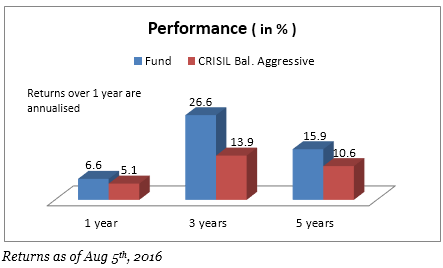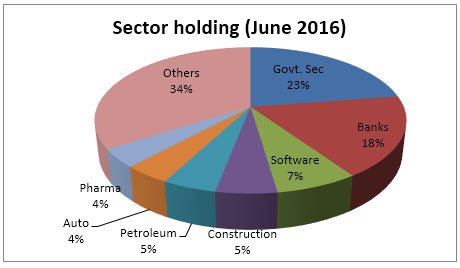It’s one of the most favoured balanced funds, and with good reason. HDFC Balanced holds a stellar record of delivering benchmark and category-beating returns at all times. In fact, its 10-year return of 15.9 per cent places it on par with the average for even equity funds.
The fund maintains an equity holding of 66-70 per cent with the rest in debt. The fund suits first-time investors who have a long-term horizon, or low-risk investors who want to temper losses during market falls. While obviously less risky than even large-cap equity funds, it nevertheless requires a holding period of at least three years.
Performance
In the 1, 3, and 5-year periods, HDFC Balanced has returned 1 to 4 percentage points above the average for balanced funds. Rolling 3-year returns daily over five years has the fund beating both the benchmark CRISIL Balanced Fund Aggressive Index and the category average all the time. Its average rolling 3-year return of 17 per cent over the past five years is unmatched by any fund with a similar history.

The mark of a good balanced fund is to limit losses in a falling market. On that front, HDFC Balanced scores well. In the 2008 crash, the fund lost 39 per cent against large cap funds’ 59 per cent average loss and balanced funds’ own 45 per cent. This was thanks to the fund cutting equity exposure in favour of debt. In a more recent example, in the turbulent market from March 2015 to February 2016, the fund lost 7.7 per cent while large-cap funds lost 10.4 and balanced funds 9 per cent, again due to a debt move.
HDFC Balanced takes among the highest mid-cap exposures, and thus delivers comparatively well during market uptrends. Its 55 per cent gain in the 2013-15 bull market, for example, is at the top of the pack. Stocks such as Aarti Industries, Blue Star, SKF India, and Tube Investments saw strong market performance.
This mid-cap allocation, however, increases the fund’s volatility in comparison to the average for balanced funds. Its comparatively higher holding in government securities over the past two years also played a part in increasing volatility – most other balanced funds stick to quality corporate bonds. HDFC Balanced makes up for volatility in its returns. On risk-adjusted returns, measured by Sharpe, the fund is close to the top. The other balanced fund from the HDFC stable, HDFC Prudence, is unable to match HDFC Balanced on all counts – ability to contain declines, volatility and risk-return payoff.
Portfolio
Like with most HDFC funds, the focus for HDFC Balanced is on sectors that can benefit from a recovery in the investment cycle, and not on consumption or defensive sectors.
 Banking currently forms the bulk of the portfolio and the holding in this sector has been at the same level for a year now. The fund cut back on software and pharmaceuticals, while adding construction, chemicals, and capital goods stocks. Its holding in energy, primarily through Reliance Industries, is also up over the past year. Automobiles and ancillaries, and some consumer durables form the fund’s consumption exposure. With all signs pointing to a broader recovery over the long term, the market should reflect the same and push up cyclical stocks as well.
Banking currently forms the bulk of the portfolio and the holding in this sector has been at the same level for a year now. The fund cut back on software and pharmaceuticals, while adding construction, chemicals, and capital goods stocks. Its holding in energy, primarily through Reliance Industries, is also up over the past year. Automobiles and ancillaries, and some consumer durables form the fund’s consumption exposure. With all signs pointing to a broader recovery over the long term, the market should reflect the same and push up cyclical stocks as well.
On the debt side, balanced funds normally hold high-quality corporate bonds and don’t actively manage it. That has changed for some funds, with holding in gilts stepped up as interest rates fall. For HDFC Balanced, almost its entire debt portfolio currently is in government securities. The fund has held at least 20 per cent of its portfolio in gilts from 2015 onwards, a move that can bring in higher returns over the next year as gilt yields ease. This is especially useful as top-rated corporate debt are offering lower returns currently. The fund hasn’t taken gilt exposures in earlier rate cut cycles.
At Rs. 6,207 crore, HDFC Balanced is also among the largest balanced funds. Chirag Setalvad is the fund’s long-standing manager.
FundsIndia’s Research team has, to the best of its ability, taken into account various factors – both quantitative measures and qualitative assessments, in an unbiased manner, while choosing the fund(s) mentioned above. However, they carry unknown risks and uncertainties linked to broad markets, as well as analysts’ expectations about future events. They should not, therefore, be the sole basis of investment decisions. To know how to read our weekly fund reviews, please click here.








And this is also a seasoned MF scheme!!
And this is also a seasoned MF scheme!!